On Thanksgiving, Kansas City kicked off the holiday season with the Plaza Lighting Ceremony. In honor of that grand tradition and all the outdoor displays this time of year, here’s a primer on how to make great pictures at night.
The challenge of night photography is the lack of light, which can mean low shutter speeds and blurry pictures. That means you have three choices: one, you can raise the ISO of your camera to get a shutter speed high enough to avoid blur (you’ll need at least 1/30 second if hand-holding). Two, you can open the aperture of your lens to its maximum, to help get that faster shutter speed. Or three, you can use a tripod. Each has strengths and weaknesses.
Raising the ISO is easy with digital cameras, but there’s a price to be paid in quality. As you go up in ISO, you risk an image defect called “noise.” That’s when you start seeing a grainy, or “chunky” appearance in the image, and a loss of color saturation. With today’s cameras, you can often go as high as 1600 or 2000 before that starts becoming a problem. However, when possible, you want to avoid those high ISOs.
Opening the aperture of the lens means going down in f/stops (changing from f/5.6 to f/4 creates a larger aperture, letting more light in). However you’ll run into limits there too, as lenses can only open so wide. Most regular lenses have a maximum (widest) aperture of f/3.5 to f/4.
Using a tripod means carrying another piece of gear, and slows down how you work. However, in this case, it’s well worth it. A good tripod is the most important accessory you can have for night photography, because it will let you shoot long shutter speeds without having to use high ISOs or wide apertures. If you want to read my recommendations on tripods, go HERE.
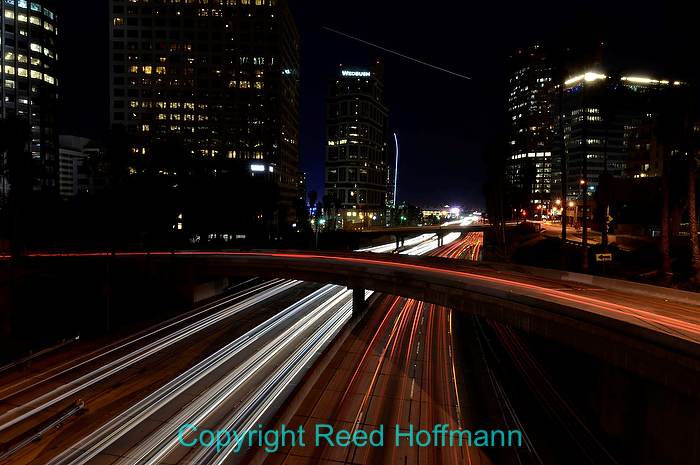
To get the streaking lights from cars passing by in Los Angeles I needed a 15-second exposure. Nikon D7000 set to white balance of Incandescent and ISO of 100, shutter speed of 15-seconds at f/16, 12-14mm f/4 lens at 14mm. Photo copyright Reed Hoffmann.
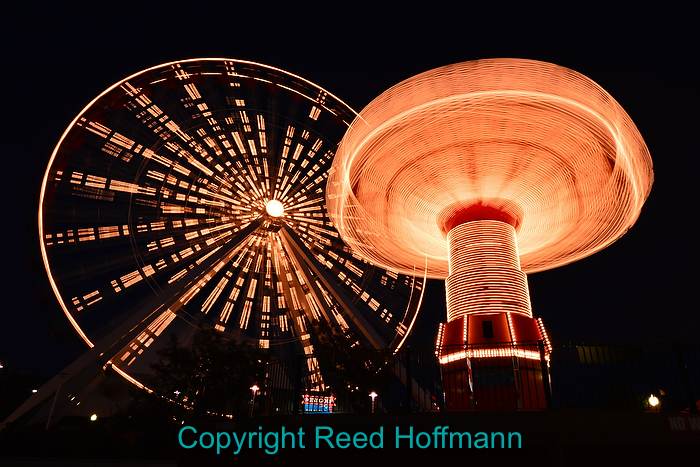
You can make beautiful night pictures even with entry-level DSLRs, if you have a tripod. Nikon D3200, white balance of Fluorescent and ISO of 100, shutter speed of 5-seconds at f/22, 12-24mm f/3.5-4 lens at 14mm. Photo copyright Reed Hoffmann.
Now that you’ve got your tripod out and ready to use, it’s time to work on focus and exposure. Since autofocus systems need light to do their thing, night photography can mean poor autofocus performance. There are a couple of solutions to that. First, if there’s anything bright in the scene (like a light), try to get your camera’s AF system to focus on that. If it achieves focus, then turn OFF the AF so the lens remains focused at that distance. Most lenses have a switch that will let you do that. The second solution also involves turning off the AF. But this time you’re doing it because you can’t get the AF system to work, so you’re turning it off to focus manually. If your camera has Live View, you can turn that on and zoom in to assist you in getting accurate focus.
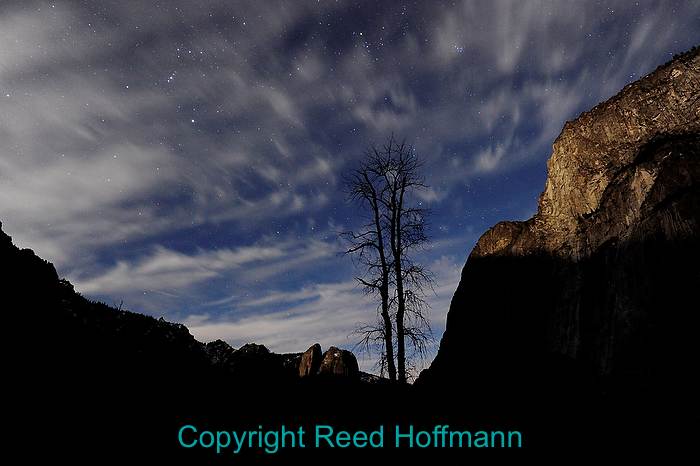
Since moonlight is the primary light source, Sunny was the best white balance for this photo from Yosemite valley. Nikon D3S, ISO of 4000, shutter speed of 15-seconds at f/5, 16-35mm f/4 lens at 17mm. Photo copyright Reed Hoffmann.
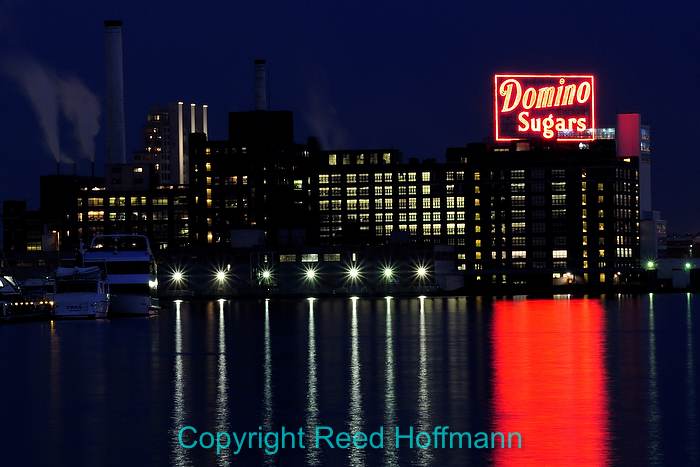
You can make these types of photos with compact cameras too, if they offer a Manual exposure mode. The reflections in the water are a nice bonus. Nikon 1 J1 set to white balance of Auto and ISO of 200, shutter speed of 8-second at f/16, 30-100mm lens at 77mm. Photo copyright Reed Hoffmann.
Once you’ve got an in-focus scene, it’s time to figure out a good exposure. This is one of those rare times where using Manual exposure is actually easier than an automatic exposure mode. Because the range of light is so great (between dark and light areas), and because there’s so much of the scene is dark in a night shot, the meter will rarely give you a reading that results in a good picture. So change your exposure mode to M (Manual) and start experimenting. Since you’re using a tripod, there’s no reason to avoid exposures that go into multiple seconds. Most of today’s cameras can shoot up to a 30-second exposure without any added accessories. The LCD on the back of the camera makes it easy to find a good exposure, but there is one pitfall to watch out for. When you’re in the dark looking at the back of your camera, it will look brighter than it does indoors or in daylight. So if the picture looks good on the back of the camera in the dark, there’s a good chance that it’s actually underexposed. So your goal is to have a scene that looks a bit brighter than you think it should. And be sure to take advantage of the highlight alert (“blinkies”) on the LCD. With that feature turned on, any area that’s overexposed will blink on and off. A properly exposed night scene that has lights in it will just have the small center of those lights flashing. This is because you’re not exposing for the light bulbs themselves, both for the illumination they provide to the surrounding area.
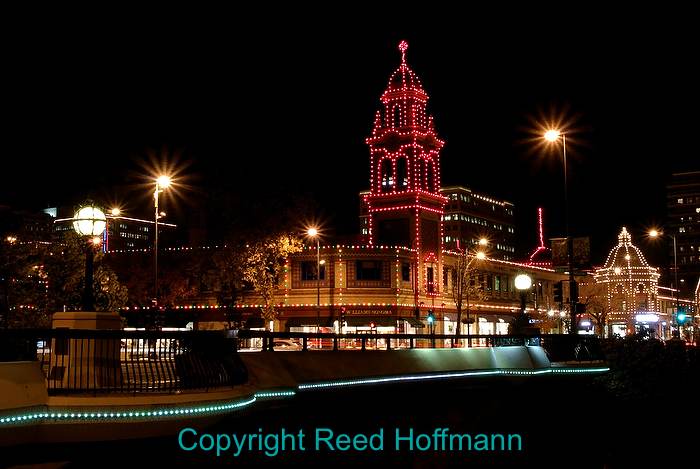
The Plaza lights in Kansas City, this time using a string of lights along the edge of a bridge to lead the viewer’s eye into the photo. Nikon 1 J1 set to white balance of Incandescent and ISO of 100, shutter speed of 13-seconds at f/16, 10-30mm lens at 16.9mm Photo copyright Reed Hoffmann.
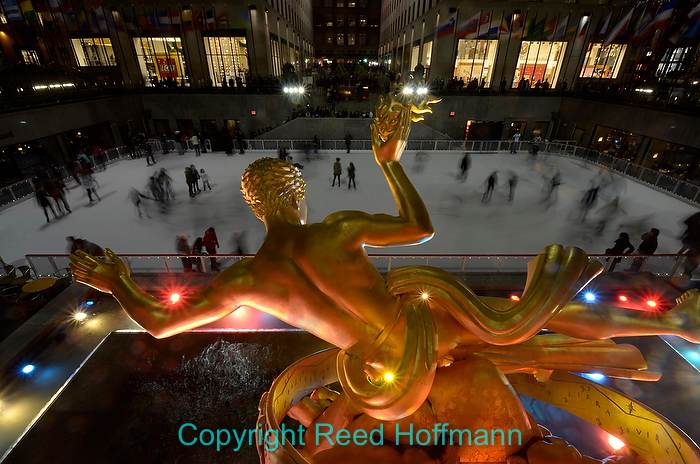
I didn’t have a tripod, but was able to make this shot by resting the camera on a ledge at Rockefeller Center in New York City. Nikon D7000 set to white balance of Auto and ISO of 200, shutter speed of 1.3-seconds at f/18, 10-24mm f/3.5-4 lens at 10mm. Photo Copyright Reed Hoffmann.
Even though you’re mounted on a tripod, there’s still a good chance you’ll add blur to the picture if you shoot it by pushing down on the shutter button. One easy way to avoid that is to use the camera’s self-timer. Many new cameras let you change that default ten-second delay to something shorter, like two-seconds. And there are also cables and remotes that will let you trip the shutter without physically touching the camera.
Finally, you should try different white balances. Auto might work (it will often make night shots that have lights in them look more yellow or orange), I’d suggest you also try Fluorescent or Incandescent. One of those might give you more realistic color, though there’s nothing wrong with experimenting with the other settings to see what happens.
One last note on exposure… Be sure and turn your camera’s flash off. Adding that artificial burst of light from the camera will only light up the foreground of your picture, and rarely looks good in these types of photos. As long as your camera’s on Manual exposure, the flash won’t fire unless you pop it up (or turn it on).
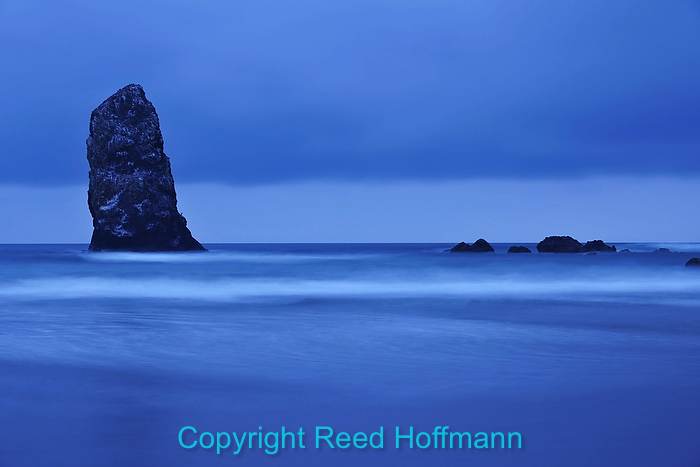
The same techniques you use for night photography apply at dusk and dawn. Haystack rocks on the Oregon coast, shot with a long exposure in the last light of the day causing the water to blur. Nikon D3X set to white balance of Sunny and ISO of 200, shutter speed of 8-seconds at f/8, 70-200mm f/2.8 lens at 82mm. Photo Copyright Reed Hoffmann.
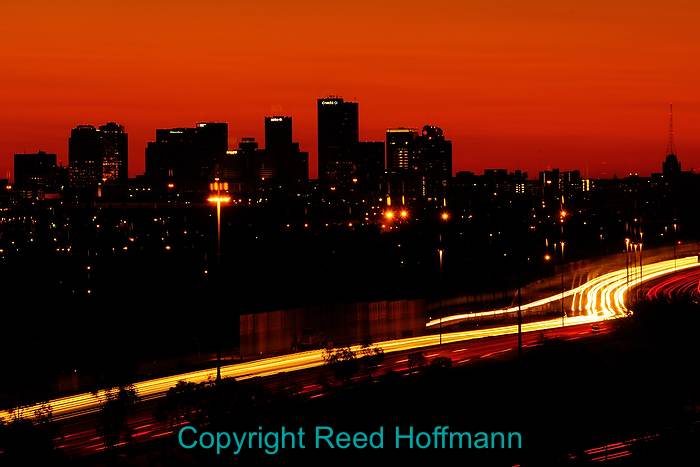
This landscape of Phoenix with a fading sunset was shot from the hallway of a local hotel without a tripod – the camera was placed on a towel on the windowsill. Nikon D300S set to white balance of Shady and ISO of 200, shutter speed of 20-seconds at f/20, 70-300mm f/4.5-5.6 lens at 180mm . Photo copyright Reed Hoffmann.
Now that you’ve got the technical covered, you can start concentrating on the creative side. That always starts with composition. Here are some suggestions:
– Is the scene best as a horizontal or a vertical?
-Study the edges of your frame carefully – is what you’re including what you really want to be there? Is there anything you need to exclude?
– What happens if you change your focal length (zoom in or out)?
– Can you shoot from a low angle? Or from a high angle?
– Is there water, or any other reflective surface you can use to add more interest to the photo?
– Are there lines that already exist to lead the viewer’s eyes to what you want them to see? Or can movement (for example cars headlights/taillights), create that line for you during a long exposure?
– Since you’re working from a tripod, you have the luxury of long exposures. And exposure can be a creative tool. Is there motion in the scene that will be changed by that exposure? Can you exaggerate that with an even longer exposure?
– Aperture can also be used creatively. Shooting very small apertures (f/16 or f/22, for example) can give small bright light sources a “sunburst” effect.
There are great pictures to be made at night, and now you’ve got the knowledge to get started. Grab your coat, hat and gloves, get out there and start shooting!
(I’m going to teach a night photography workshop on the Plaza here in Kansas City in the next few weeks. If you’re interested in attending, drop me an email at reed@reedhoffmann.com and I’ll let you know when it’s scheduled)


Great art- watched your Nikon video very helpful, trying to make time for your Canada trip, I have a d7000 , 50m 1.4 , 17-55 2.8 , 12-24 and tri pod, going to try and catch blue tide tonight, thinking 50m white balance incandescent, iso 2k 10 second , thoughts?
Hi Jim. You might find the Incandescent setting to be too blue, the Fluorescent might be better. And as for lenses, I’m a big fan of having a foreground subject using a wide-angle. So depending on the setting, I might reach for the 17-55. As for exposure, play with it. If there’s water movement, I’d try anything from 1/4 to 20-seconds. Have fun!